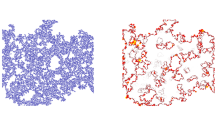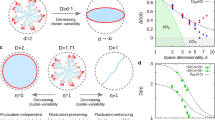Abstract
A granular system slightly below the percolation threshold is a collection of finite metallic clusters, characterized by wide spectrum of sizes, resistances, and charging energies. Electrons hop from cluster to clusters via short insulating “links” of high resistance. At low temperatures all clusters are Coulomb blockaded and the dc-conductivity σ is exponentially suppressed. At lowest T the leading transport mechanism is variable range cotunneling via largest (critical) clusters, leading to the modified Efros-Shklovsky law. At intermediate temperatures the principal suppression of ρ originates from the Coulomb zero bias anomaly occurring, when electron tunnels between adjacent large clusters with large resistances. Such clusters are essentially extended objects and their internal dynamics should be taken into account. In this regime the T-dependence of ρ is stretched exponential with a nontrivial index, expressed through the indices of percolation theory. Due to the fractal structure of large clusters the anomaly is strongly enhanced: it arises not only in low dimensions, but also in d = 3 case.
Similar content being viewed by others
References
Disorder and Granular Media, Ed. by D. Bideau and A. Hansen (North-Holland, Amsterdam, 1993).
Nanocomposite Science and Technology, Ed. by P. M. Ajayan, L. S. Schadler, and P. V. Braun (Wiley-VCH, Weinheim, 2003).
Single Electron Tunnelling, Ed. by H. Grabert and M. H. Devoret (Plenum, New York, London, 1992).
D. Stauffer and A. Aharony, Introduction to Percolation Theory (Taylor and Fransis, London, 1994).
A. Bunde and S. Havlin, Percolation I, in Fractals and Disordered Systems, Ed. by A. Bunde and S. Havlin (Springer, Berlin, 1996).
The term “touching” does not necessarily mean direct metal-metal contact. In some systems a thin insulating (e.g., oxide) layer still separates two touching grains, but its thickness is much smaller than for nontouching grains.
J. Zhang and B. I. Shklovskii, Phys. Rev. B 70, 115317 (2004).
M. V. Feigelman and A. S. Ioselevich, JETP Lett. 81, 341 (2005).
I. S. Beloborodov, A. V. Lopatin, and V. M. Vinokur, Phys. Rev. B 72, 125121 (2005).
A. L. Efros and B. I. Shklovskii, J. Phys. C 8, L49 (1975).
A. S. Ioselevich and D. S. Lyubshin, JETP Lett. 90, 746 (2009).
B. I. Shklovskii and A. L. Efros, Electronic Properties of Doped Semiconductors (Springer, Berlin, 1984).
A. L. Efros and B. I. Shklovskii, Phys. Stat. Solidi B 76, 475 (1976).
B. L. Altshuler and A. G. Aronov, in Electron-Electron Interactions in Disordered Solids, Ed. by A. L. Efros and M. Pollak (North-Holland, Amsterdam, 1985).
A. M. Finkelshtein, JETP 57, 97 (1983); A. M. Finkelstein, JETP 59, 213 (1984).
Yu. V. Nazarov, JETP 68, 561 (1990); Yu. V. Nazarov, Phys. Rev. B 43, 6220 (1991); G.-L. Ingold and Yu. V. Nazarov, “Charge Tunneling Rates in Ultrasmall Junctions,” Ch. 2 in [3], p. 21.
L. S. Levitov and A. V. Shytov, JETP Lett. 66, 214 (1997).
E. G. Mishchenko, A. V. Andreev and L. I. Glazman, Phys. Rev. Lett. 87, 246801 (2001).
R. Egger and A. O. Gogolin, Phys. Rev. Lett. 87, 066401 (2001).
M. V. Feigelman and A. S. Ioselevich, JETP Lett. 88, 882 (2008).
N. F. Mott, J. Non-Cryst. Solids 1, 1 (1968).
Author information
Authors and Affiliations
Additional information
The article is published in the original.
Rights and permissions
About this article
Cite this article
Ioselevich, A.S. Coulomb zero bias anomaly for fractal geometry and conductivity of granular systems near the percolation threshold. Jetp Lett. 91, 40–47 (2010). https://doi.org/10.1134/S0021364010010108
Received:
Published:
Issue Date:
DOI: https://doi.org/10.1134/S0021364010010108




